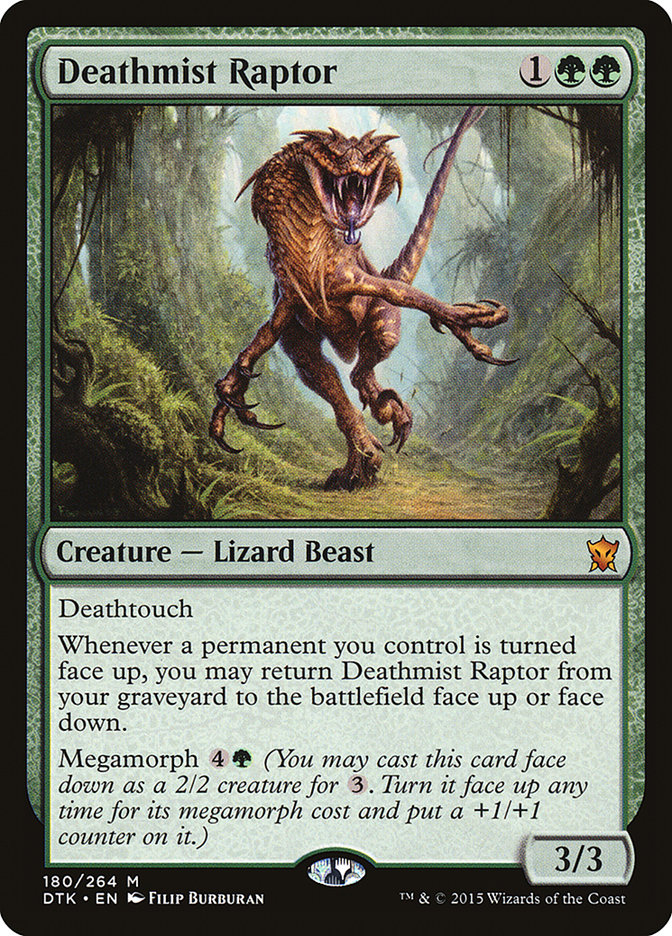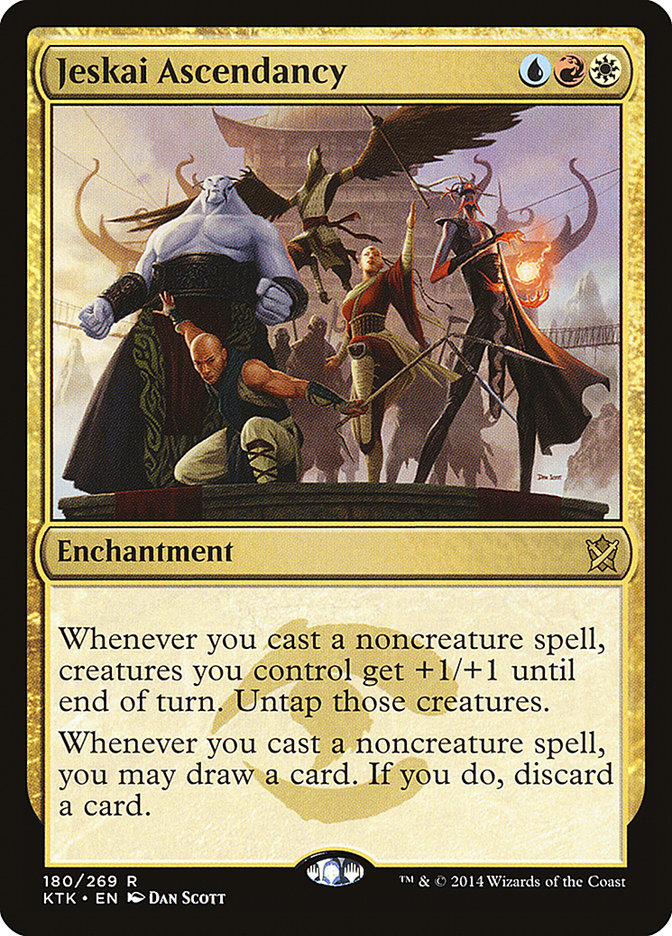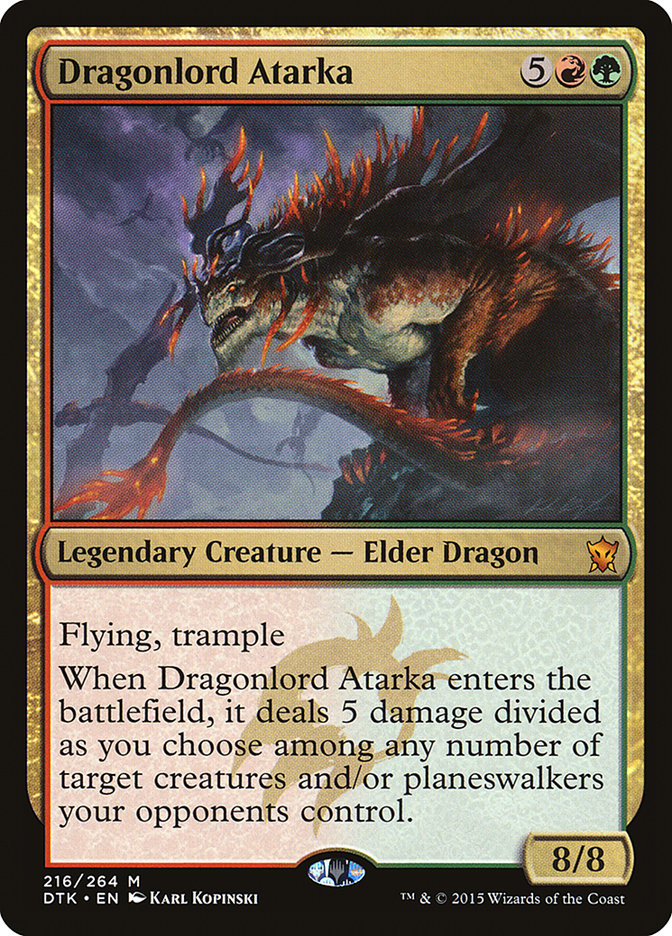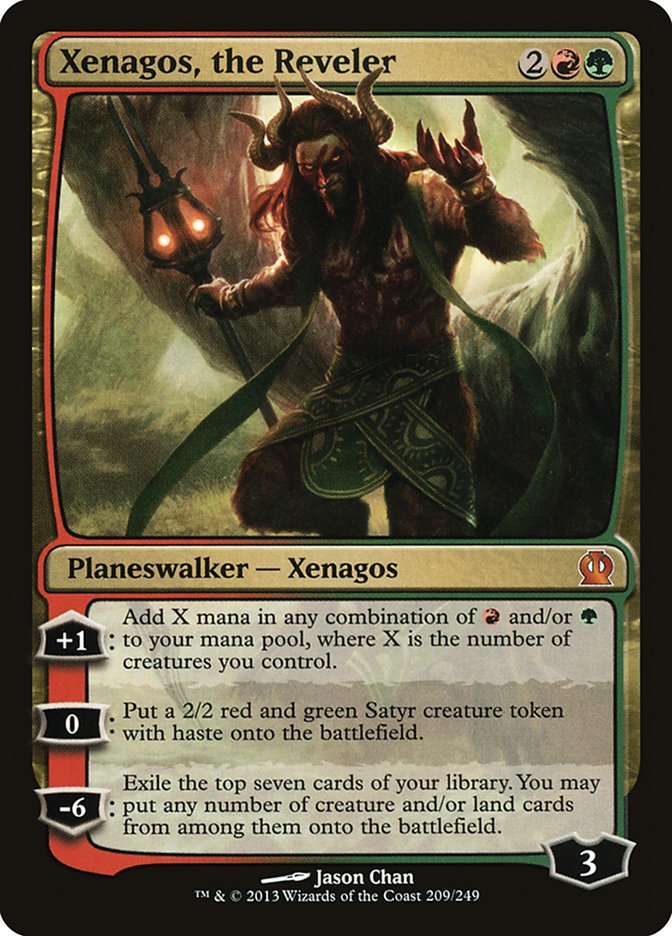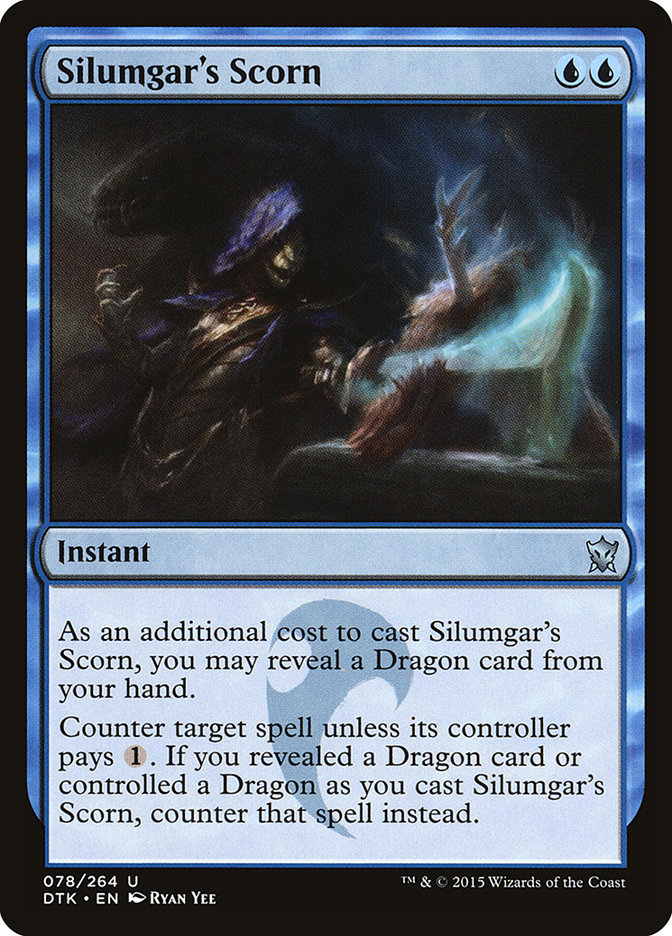Standard is all about cycles and metagame steps this year. Since a couple weeks ago when G/R Dragons made a resurgence, the metagame has taken a couple steps ahead to G/R Devotion as a trump. While the world was watching G/R Tron and Amulet Bloom duke it out in Modern, very few people pointed out that a full HALF of the Invitational Top Eight made their way there piloting Nykthos-backed Dragonlord Atarkas in the Standard rounds.
That all said, at a Grand Prix you can’t really just plan to beat the new hot thing. You have to be able to hold your own against the previous level of people whose local metagame hasn’t caught up on top of that, and possibly even go a level deeper and beat the well-prepared people who have shown up with decks that do these two things.
In the interests of meeting all of these criteria, this is how to approach each matchup. How to attack them, how not to attack them, and more.
Where We Came From: Deathmist Raptor
Deathmist Raptor Megamorph isn’t necessarily the most important card or archetype to beat in Standard, but I’m starting with it as it was the original driver that pushed Standard in this direction after control decks dominated the Pro Tour. It’s also worth noting that this card is still a fixture despite the metagame moving to fight it, much like we’ve seen with Siege Rhino. Very few cards in Standard can really claim this.
Deathmist Raptor is just good. Gnarled Mass is neither the worst nor the best rate, but it attacks reasonably, blocks reasonably, and grinds reasonably. There are metagames where it would be bad, but we currently just aren’t in one.
Things That Should Work But Don’t
In theory, the best thing to do if people are slowing their clocks to durdle around with on board card advantage is just to not interact. You can either play something that goes way over the top or just kill them without trying to push through on board.
Ugin is the biggest of the big things in the current Standard format. In theory, bogged down Deathmist loops should be something it just ends… except the whole part where the –X ability doesn’t hit face-down creatures. If the Deathmist Raptor player expects an Ugin, they can keep a careful balance of face-up and face-down creatures in play to make sure that no matter what happens, the Spirit Dragon only handles part of the board state.
This deck is so close. Again, slow clocks and bogging down boards should favor the infinite combo deck…
Except Deathmist Raptor’s partner in crime is a pain for linear decks. Den Protector amplifies the effect of each card capable of interacting with the combo, and this often means Thoughtseize is along for the ride. Not that Ascendancy isn’t capable of beating these kinds of shenanigans, but instead of being a bye it’s just become more hoops to jump through. Every time the Deathmist deck draws their Dromoka’s Command (oh yeah, forgot to mention that card too) they get to kill multiple Ascendancies, forcing you to Dig (through Time) even deeper to find a kill. Your own Den Protectors help, but then you are just settling into the grindy game they were trying to make you play.
Oh yeah, and while we’re at it, Duress on top of Thoughtseize also sucks. Dragons of Tarkir was not very kind to combo in Standard. A lot of the above also applies to G/W Devotion, which would be great if it wasn’t just getting two-for-oned over and over by Dromoka’s Command.
Things that Do Work:
When all else fails, dragonfire cleans up the mess.
Unlike Ugin, the Spirit Dragon, Atarka is indiscriminate in what she kills. Morphs, Raptors, the other cards they decided to play. Just dead. 8/8 is also just gigantic. Maybe your Dragon doesn’t mop up absolutely everything when it enters the battlefield, but Atarka clears out your opponent soon after which in turn clears their board state and clears the match slip from the table.
But the real driver behind Dragonlord Atarka is that she never happens just once. You land the first copy, and maybe your opponent has an answer in time. Except it they do, then you Genesis Hydra and easily find another or activate Haven of the Spirit Dragon and the same copy comes back for a second round. It’s not like your opponent can really gain tempo on the exchange either, as their board was also destroyed and they likely don’t have the pressure to punish you for trading seven mana for a three-mana Hero’s Downfall.
Water is wet. Sky is blue. Elspeth still wins Abzan mirrors.
Despite Den Protector’s Wandering Wolf ability making sure Soldier tokens can’t block it, Elspeth is still a trump. It certainly doesn’t hurt that Den Protector is really bad at attacking into Siege Rhino. Deathmist Raptor is a midcost creature without evasion, which turns out just run into Soldiers over and over until the player with Elspeth attacks with twenty power of flying creatures.
Where We Are, Part A: Xenagos, the Reveler
It’s odd to start with this card when it is definitely less important than the other card associated with it, but it’s almost as game-dominating as the other card it almost always is played alongside of.
Xenagos is a card that runs away with games really fast. Whether it’s the ones where the first 2/2 Satyr goes unblocked and the player trying to catchup is just always falling incrementally behind to the hasted beatdown or the ones where Xenagos can’t be killed on the first attack and starts +1’ing into seven drops way too early, Xenagos isn’t really a card you can ignore.
Things That Don’t Work:
Anything that leaves Xenagos in play.
As stated above, you don’t just ignore Xenagos. Unless you basically kill everything else the G/R player has in play, Xenagos is going to do something that pushes them into the next phase of their game and it will be almost impossible to fight your way out of.
Things That Do Work:
Undercosted multicolored creatures:
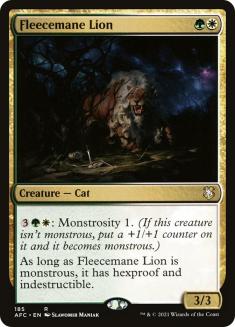
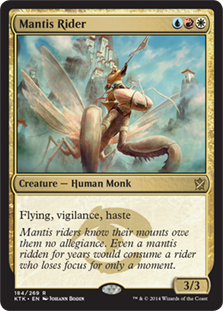

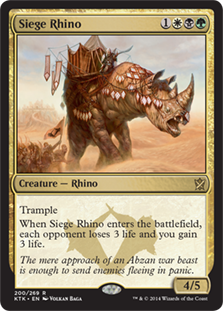
Turns out 2/2 bodies and starting at three loyalty don’t have anything on some of the high-rate threats we have seen over the last two years. Honestly, the best answer to Xenagos is to just hit it (or your opponent) really hard. While Xenagos is great at running away with a game, it’s much worse at pulling a game back from behind if the 2/2 tokens are on constant chump duty.
Burn spells:
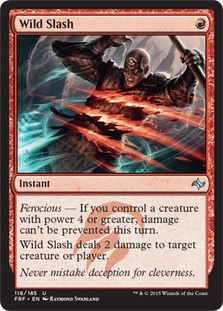
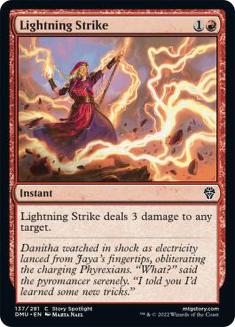
It isn’t actually the red creatures that are good against Xenagos, it’s the red spells. While a stream of 2/2 tokens seems like it could hold off a bunch of 1/1s, the red deck rarely cares about its disposable threats. It’s far more interested in the fact that it can trade a one- or two-mana card for a four-mana planeswalker, or more concretely trade a fraction of a turn for a full one. This kind of exchange is the bread and butter of the red deck and honestly a key point of its own on how other decks fail against them. If it’s really easy for them to trade for your play at tempo, it probably isn’t a winning line.
Where We Are, Part B: Dragonlord Atarka
The Queen hungers for victory.
As stated above, Atarka eats everything. Creatures, planeswalkers, players. It’s the half of a Cruel Ultimatum that depletes your opponent’s resources, just in a more tangible package.
Things that Don’t Work:
Trying to kill the Dragonlord.
You would assume that the player trying to cast the seven-mana Dragonlord would have to expend a large number of resources into playing the card. You would be right. Seven actual cards that make mana isn’t a trivial thing to produce while still having enough action to stay alive. If the 8/8 flier you are buying into dies, it should be something that leaves both players crippled with the player that isn’t playing a ton of mana sources in a better position to draw out of it.
This doesn’t work out half as well as you would want it to.
The part of the card that mimics the other half of Cruel Ultimatum where the caster gets put super far ahead towards the next backbreaking spell comes with how easy it is to find and cast the second Atarka. Deathmist Raptor, Haven of the Spirit Dragon, and Genesis Hydra are all really good at making this happen. Getting past the first Atarka isn’t really a situation where you are drawing live to more action than they are, it’s a situation where you are scrambling to draw to enough action before the next Atarka puts you right back where you started.
Thoughtseize is just not a winning line against G/R decks in this format when casts out of the G/B decks that typically deploy it.
You would assume that the plan of Thoughtseize your big card and win when you don’t have it works against these ramp-ish decks, but they are just too threat dense for it to really stop them. Here’s what actually happens when most decks try to Thoughtseize the Dragonlord Atarka deck, Choose Your Own Adventure-style.
Thoughtseize early.
Thoughtseize midgame.
Thoughtseize late.
Things That Do Work:
Not playing things that Atarka kills.
This and all the other points revolving around beating Atarka are really just lessons in recent event history. File this under why Esper Dragons dominated the Pro Tour.
If Atarka is just a seven mana 8/8, that is easy to beat. They tap seven mana, you tap three, the game moves on. If they try to do it again, repeat.
Answer Atarka without the trigger.
Wait, didn’t I just say Thoughtseize was bad?
Yes, but this slightly different. As with Esper Dragons, it turns out if you make your opponent invest a turn into Atarka and it doesn’t kill your creatures, the card is very bad.
Disdainful Stroke is really the best way to accomplish this while playing creatures, as was showcased in the Bant Midrange deck that saw a smattering of high finishes at and following the Pro Tour. The other counterspells in the format aren’t bad, but it’s hard to build a non-control deck that supports Dissolve or Silumgar’s Scorn.
Killing them first.
This was the plan my team opted to deploy in Belgium with our Nasty Surraksty Abzan Aggro deck. Play an attacker early. Spend the next turn killing their thing if they play one that matters or playing another attacker if they don’t. Bash. Repeat enough times that your opponent is dead. Instead of wasting our turn on a Thoughtseize, we spent it on a removal spell that also wasted their turn. Their increment of one land per turn was easily outpaced by our massive chunks of damage in the same time frame. Mono-red has a similar plan, and it works so long as Courser of Kruphix doesn’t decide to get in the way.
Where We Are Going: Silumgar’s Scorn
Back to the beginning. Silumgar’s Scorn drove off Atarka the first time, and it can do so again.
Here’s the difference and why this section looks different than the last two: People know about Deathmist Raptor this time. The Devotion decks are playing it and Den Protector and have a real plan for you. They aren’t favorites, but the matchup is far from easy. As a result, a lot of the decision to move down this road isn’t as straightforward as it was two months ago.
This puts Esper Dragons in a real bind and creates some interesting pinches. How many Foul-Tongue Invocations can you play when everyone still has Raptor fodder for it? If you skimp on that card, does it hurt you in the mirror when facing down opposing Dragonlord Ojutais? Can you lean on Crux of Fate when people are playing this mix of Dragons and Whisperwood Elementals, or do you have to fall back on more Perilous Vaults?
Honestly, I don’t have a solid answer for a lot of these questions. More realistically, the place I’m trying to look is much different. This appears to be a significant divergence from the previous cycle iteration.
My most likely prognosis? The best answers are to skip a step or find a new path. For the next week, this is my goal. I’m not sure where I’m starting or ending, but that’s what a week of testing is for.

